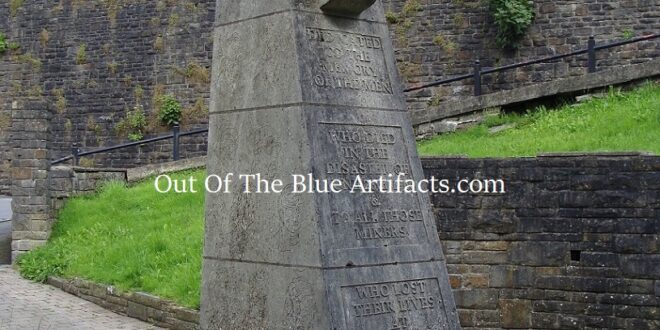Six Bells Disaster June 1960.
On Tuesday 28th of June 1960, at about 10.40am an explosion occurred in the No5 Pit W-District at the Six Bells Colliery, Abertillery, with forty-five men sadly losing their lives.
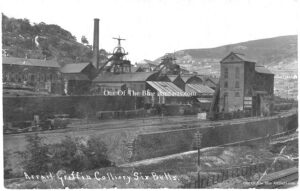 Details of the Colliery.
Details of the Colliery.
The Six Bells Colliery (as seen left) formerly known as the Arrael Griffin Colliery No4 and No5 was in the number 6 Area of the National Coal Board’s South Western Division, situated at Six Bells in the Western Valley of Monmouthshire. The Arrael Griffin Colliery was sunk in 1891 by Messrs J. Lancaster & Co. At the time of the disaster the colliery was connected to the nearby Vivian Colliery, half a mile away to the north. The connection to the Vivian Colliery was for downcast ventilation and man-riding purposes only.
The Arrael Griffin Colliery was re-named the Six Bells Colliery in the 1950’s.
There were 1,213 men employed below ground at the Six Bells Colliery and 239 men on the surface. The out-put was about 1,800 tons of saleable coal per day. The colliery had always been a safety lamp mine. There were 1,450 electric cap lamps, 85 flame lamps, for use by workmen as firedamp detectors, with 79 internal re-lighter type flame lamps for use by officials.
The under-manager of No5 pit, which included W-District, was Mr F. White. The colliery manager was Mr V. Luther. The group manager was Mr R. Williams, the area production manager was Mr A. E. Hiscox and the area general manager was Mr L. Walker.
The List of the 45 Victims.
The forty-five victims of the explosion were as follows –
Mr Ivor James Bainton aged 48 (Cutterman):
Mr Daniel James Bancroft aged 46 (Collier on Panzer):
Mr Robert Charles Brown aged 35 (Roof Control Officer):
Mr Frank Cooper aged 44 (Supplies Man):
Mr Joseph Corbett aged 50 (Haulier):
Mr Thomas George Crandon aged 46 (Repairer):
Mr Walter Thomas Davies aged 34 (Borer):
Mr Roydon James Edwards aged 27 (Repairer):
Mr Percy Gordon Elsey aged 52 (Repairer):
Mr Albert John Evans aged 34 (Packer):
Mr Leonard Keith Frampton aged 29 (Collier):
Mr Albert Gardner aged 59 (Assistant Cutterman):
Mr George Goldspink aged 37 (Repairer):
Mr Clive Alan Griffiths aged 18 (Prop Checker):
Mr Vernon Alexander Griffiths aged 33 (Deputy Grade I):
Mr Ernest Victor Harding aged 51 (Deputy Grade I):
Mr Idris Jones aged 57 (Packer):
Mr John Percival Jones aged 56 (Repairer):
Mr Joseph John King aged 56 (Packer):
Mr Dennis Edmund Lane aged 19 (Wireman):
Mr George Henry Luffman aged 55 (General Workman):
Mr Telford Cecil Mapp age 42 (General Workman):
Mr Herbert Amos Mayberry aged 55 (Dumper):
Mr William John Morden aged 52 (Engine Driver):
Mr Sidney Moore aged 54 (Repairer):
Mr Colin Malcolm Donald Morgan aged 26 (Repairer):
Mr Colin Reginald Morgan aged 22 (Assistant Repairer):
Mr Roy Martin Morgan aged 44 (Repairer):
Mr Iswyn Morris aged 44 (Deputy Grade II):
Mr Anthony Verdun Partridge aged 20 (Assistant Borer):
Mr William Henry Partridge aged 45 (Borer):
Mr Trevor Paul aged 25 (Assistant Repairer):
Mr Wilfred Alfred Charles Phipps aged 60 (Cutterman):
Mr Albert George Pinkett aged 45 (Collier):
Mr Frederick Rees aged 37 (Fitter Grade II):
Mr Mansel Reynolds aged 21 (Measurer):
Mr William Glyn Reynolds aged 21 (Assistant Repairer):
Mr Wilfred Hughes Thomas aged 57 (Repairer):
Mr Arthur Waters aged 37 General Workman):
Mr Phillip John Watkins aged 53 (Engine Driver):
Mr Wilfred Weston aged 47 (Water Infuser on Panzer):
Mr Frederick White aged 58 (Under-Manager):
Mr William Burdon Whitttingham aged 55 (Assistant Repairer):
Mr Richard John Williams aged 51 (General Workman):
Mr John Woosnam aged 24 (Fitter Grade I):
The Funerals.
On Saturday 2nd of July 1960, the bodies of twenty-six of the victims were buried at the cemetery, Brynithel. Other burials were performed at Blaina and at Brynmawr.
The Official Inquiry.
The official inquiry into the explosion at the Six Bells Colliery on the 28th of June 1960 opened on the 19th of September 1960 in number 2 court of the Civic Centre, Newport. The following inquest into the disaster stated the most probable cause of the explosion was an accumulation of firedamp gas being ignited by a spark caused from the friction from a fall of quartzitic rock onto the face panzer canopy. This explosive flame was fed by coaldust in the roadways in the district. Of the many possible causes of the fatal explosion at Six Bells Colliery debated in the lengthy inquiry, this was seen as the most plausible cause.
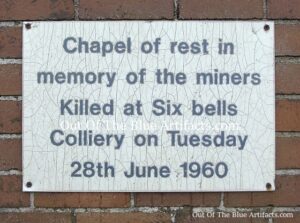 The Chapel of Rest at Brynithel and the Dedication.
The Chapel of Rest at Brynithel and the Dedication.
On Friday 2nd September 1988 the chapel of rest memorial at Brynithel Cemetery mortuary was officially opened and dedicated to the memory of the miners who lost their lives in the disaster at Six Bells Colliery on 28th June 1960, many of whom were laid to rest at Brynithel Cemetery. The report stated the families of those who lost their lives were invited to be present. This dedicatory plaque (as seen right) is now on the outside wall of the mortuary.
The Six Bells Colliery Canteen Clock.
Later, in September 1988 the clock that used to hang in the Six Bells Colliery Canteen was presented to the borough mayor Mr Peter Law by Mr Brian Phelps the chairman of the Six Bells Lodge on behalf of the N.U.M. The gift of the clock was to commemorate the victims of the Six Bells Colliery disaster of 1960. A report in the Gwent Gazette states the clock will be placed in the chapel of rest at the old mortuary Brynithel Cemetery, dedicated to the men who died.
Specially Commissioned Memorials.
It was 35 years before a specially commissioned memorial was first proposed and constructed.
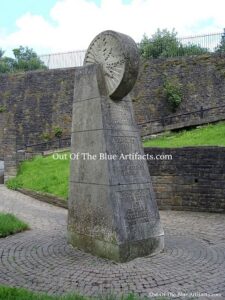 The First Memorial.
The First Memorial.
The first Six Bells Colliery Disaster Memorial (as seen left) was erected on ground at Chapel Road, Six Bells and unveiled in the last week of August 1995. The memorial was unveiled by the mayor Mr Ron Rowlands and dedicated by his chaplain Mrs Vivienne Nicholls. The artist and architect was Mr Robert Kennedy of Cardiff. The memorial was made of Portland stone and stood twelve and a half feet high. It was sited in a memorial garden on land just off Chapel Road, below Bridge Street, Six Bells. The stone memorial, a tapered monument incorporating a pit wheel on the top with a miner’s lamp and etchings in the form of portraits of twenty-six local people was part of a £23,000 environment improvement scheme by the Blaenau Gwent Borough Council and Community Design for Gwent.
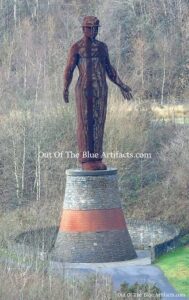 The Second Memorial.
The Second Memorial.
In about 2007 a new larger memorial was planned, this new memorial was to be called the Guardian, a figure of a miner with his arms outstretched by its side, standing on a stone plinth on which were placed the names of the victims of the disaster on plaques around the base and sited in the colliery grounds. It was to be made from Corten Steel and designed by the sculptor Mr Sebastien Boyesen. It was partly erected in time for the 50th anniversary of the disaster held on Monday 28th June 2010 and dedicated by the Arch-Bishop Mr Rowan Williams, which many people attended the memorial service at the site. The miner’s memorial statue (as seen right) was finally completed and now stands just south of the grounds of the colliery.
Points of Interest – Carved onto the plaque of the old memorial at Chapel Road are the words “Dedicated to the memory of the men who died in the disaster of June 1960 and to all those miners who lost their lives at the Six Bells Colliery 1897-1988”. What I can’t believe is how the designer Mr Robert Kennedy only dedicated the memorial to those miners who sadly lost their lives between those dates. The colliery sinking began in 1891 and there were a few miners who were killed after this date though before 1897 but it seems they were sadly forgotten. Below is a list of the fatalities that occurred before 1897.
Six Bells Colliery – Fatalities 1891-1897.
The First Sinking Accident.
On Saturday 9th of February 1895, four men fell to their deaths down the shaft while sinking the Arrael Griffin Colliery, Six Bells, Abertillery.
Mr William Matthews aged 36, of Pontnewydd.
Mr William Lusty aged 21, of 6 Court Terrace, Llanhilleth.
Mr John Lamb aged 37, a lodger at Blaenau Gwent, Abertillery.
Mr Thomas Day a lodger at Mitre Street, Abertillery.
On Thursday 14th of February 1895, the inquest was held at the Reading Rooms, Cwmtillery into the circumstances of the accident that had occurred. The sinking gang had been in the bowk and lowered down the shaft, which at this time was 240 yards deep, the bowk collided with scaffolding that was in the shaft 40 or 50 yards from the bottom, the collision tipped the bowk and four of the men fell to their deaths. The details of a bowk can be seen below.
Some of the sinking team that attended the official inquest.
Mr James Bennett (Sinker); Mr David Hayland or Hagland? (Sinker); Mr Thomas Drew (Engine Driver); Mr John Cowley (Banksman); Mr John Dere (Sinker); Mr James Jones (Chargeman); Mr David Phillips (Chargeman); Mr Richard Bates (Sinker); Mr Owen Richards (Banksman):
Mr William Lusty was buried at Llanhilleth Churchyard and the remains of Mr John Lamb and John Day were interred at Blaina Churchyard.
The Second Sinking Accident.
In April 1895 another accident occurred in the shaft at Arrael Griffin Colliery Six Bells, Abertillery resulting in the death of a Chargeman.
Mr Eli Morgan aged 36 (Chargeman):
On Thursday 13th of April 1895, the official inquest took place (no venue mentioned in the reports) into the circumstances of the accident that had occurred Mr Morgan was in charge of the shift putting in water pipes down the shaft, he was 40 yards from the surface when he fell to his death.
Some of the sinking team that attended the official inquest.
Mr James Townrow (Master Sinker); Mr Samuel Morgan (Sinker); Mr George Jones (Sinker); Mr Albert John Phipps (Banksman):
The Third Sinking Accident.
On Thursday 2nd of May 1895, a serious accident occurred at the Arrael Griffin Colliery Six Bells, Abertillery. Two sinkers named Mr Herbert and Mr Kyle were seriously injured by a fall of the side in the shaft. It was reported Mr Jacob Kyle was slightly injured though Mr James Jacob Herbert was conveyed home where he succumbed to his injuries four hours later.
Mr James Jacob Herbert aged 40 (Sinker) of 74 Edward Street, Blaenau Gwent, Abertillery.
On Saturday 4th of May 1895, the official inquest took place at the Police Station, Abertillery into the circumstances of the accident that had occurred
Some of the sinking team that attended the official inquest.
Mr Frederick Meek (Sinker); Mr Richard Wiltshire (Chargeman):
(More information to be uploaded).
Points of Interest – A bowk is a large bucket like container attached to the winder via the rope and wheels of the headframe. It is used to wind the sinking teams up and down the shaft and to also carry the waste up the pit while sinking is in progress.
Sinking Procedure.
During the sinking of a pit, a platform rig made of wood, the same diameter of the shaft is suspended on a series of pulleys to enable its lowering and raising, up and down the shaft. This platform rig has a hole in its center which is equipped with a trapdoor, the same diameter as the bowk. There are a number of rock borers attached to the platform rig in a circular pattern of varying angles, when the platform rig is at ground level in the shaft, the sinkers bore a series of blasting holes down through the rig into the rock below, normally 6′ feet in depth.
The platform rig is then lifted clear to a safe distance. The men charge the holes with dynamite, climb into the bowk and come to the surface to safely detonate the explosives. The platform rig is then lowered to about 10′ feet from the ground, the sinkers descend the shaft in the bowk which is lowered though the hole in the platform rig into the disturbed ground. They then fill the bowk with the waste material and it makes a series of trips up and down the shaft to clear the ground below. During this time the sinkers use the platform rig as a safety guard preventing any debris falling onto them while they clear the waste below while the bowk travels through the platform rig through the trap door in the center.
After each stage of boring, blasting and clearing, the sinkers masons’ team brick the walls of the shaft. They start with a wide-lipped iron ring which is normally in sections for easy transport but is bolted together which forms a ring the same diameter as the shaft. They bolt the ring into the side of the shaft at ground level, they then brick up the walls of the shaft to the last section’s iron ring. After the cement has set in the brickwork, the procedure starts all over again.
The pressure on the rock formation strata in the South Wales Coalfield caused the coal seams to dish making it a coal basin, the southern part of the basin is way south while the northern outcrop is along the Heads of the Valleys. The depth of each colliery depends on its location, further north the shallower i.e., the depth of Blaenavon Big Pit Colliery is said to be about 96 yards or 290′ feet, while the further south, at its deepest is the Nantgarw Colliery which is said to be at least 856 yards or 2,568′ feet in depth.
 Out Of The Blue Artifacts A Library of a lifetime of collecting
Out Of The Blue Artifacts A Library of a lifetime of collecting
